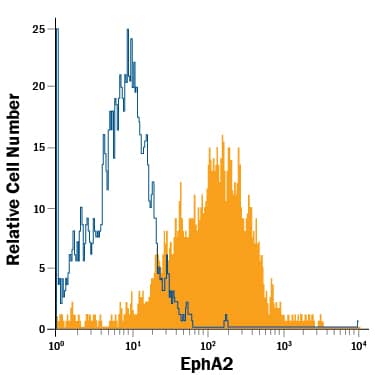Human EphA2 Alexa Fluor® 700-conjugated Antibody
R&D Systems, part of Bio-Techne | Catalog # FAB3035N


Key Product Details
Species Reactivity
Applications
Label
Antibody Source
Product Specifications
Immunogen
Gln25-Asn534
Accession # P29317
Specificity
Clonality
Host
Isotype
Scientific Data Images for Human EphA2 Alexa Fluor® 700-conjugated Antibody
Detection of EphA2 in A431 Human Cell Line by Flow Cytometry.
A431 human epithelial carcinoma cell line was stained with Mouse Anti-Human EphA2 Alexa Fluor® 700-conjugated Monoclonal Antibody (Catalog # FAB3035N, filled histogram) or isotype control antibody (Catalog # IC003N, open histogram). View our protocol for Staining Membrane-associated Proteins.Applications for Human EphA2 Alexa Fluor® 700-conjugated Antibody
Flow Cytometry
Sample: A431 human epithelial carcinoma cell line
Formulation, Preparation, and Storage
Purification
Formulation
Shipping
Stability & Storage
Background: EphA2
EphA2 (Erythropoietin-producing Hepatocellular Carcinoma-A2), also known as Eck, Myk2, and Sek2, is a 120-130 kDa member of the Ephrin receptor subfamily, tyrosine protein kinase family of molecules. It is one of at least 13 mammalian subfamily members that are divided into two groups (A and B) that are named for the corresponding class of ligand (Ephrins [Eph-receptor Interacting Protein]) to which they bind (1, 2). Mature EphA2 is a 953 amino acid (aa) type I transmembrane glycoprotein that contains a 514 aa extracellular domain (ECD). The ECD is characterized by the presence of one Eph ligand-binding domain and two fibronectin type III repeats. EphA2 binds Ephrins A1-A5, with subsequent receptor oligomerization and signal transduction (1, 2). It also exists, however, in a ligand-independent, auto-activated monomeric and inactive, homodimeric state, leading to complexities in its actions (3). Further, it is also known to form heterodimers with EphB6, a kinase-negative receptor that dampens EphA2 activity (4). EphA2 is expressed by a wide variety of cell types, including osteoblasts, neurons, capillary endothelium, Schwann cells, keratinocytes, Langerhans cells (LC) and IDC (mature LCs), cortical lens fiber cells and placenta-derived mesenchymal stem cells where EphA2 may serve as a biomarker (2, 5-11). Over aa 25-534, human and mouse EphA2 share 91% sequence identity.
References
- Lisabeth, E.M. et al. (2013) Cold Spring Harb. Perspect. Biol. 5:a009159.
- Park, J.E. et al. (2013) Genes 4:334.
- Singh, D.R. et al. (2015) J. Biol. Chem. 290:27271.
- Akada, M. et al. (2014) Cell. Signal. 26:2879.
- Matsuo, K. et al. (2012) Cell Adh. Migr. 6:148.
- Thundyil, J. et al. (2013) PLoS One 8:e53528.
- Funk, S.D. et al. (2012) Arterioscler. Thromb. Vasc. Bio. 32:686.
- Afshari, F. et al. (2010) J. Neurosci. 30:4246.
- Lin, S. et al. (2010) Mol. Biol. Cell 21:3902.
- de Saint-Vis, B. et al. (2003) Blood 102:4431.
- Shen, S-P. et al. (2015) Taiwan J. Obstet. Gynecol. 54:749.
Alternate Names
Gene Symbol
UniProt
Additional EphA2 Products
Product Specific Notices for Human EphA2 Alexa Fluor® 700-conjugated Antibody
This product is provided under an agreement between Life Technologies Corporation and R&D Systems, Inc, and the manufacture, use, sale or import of this product is subject to one or more US patents and corresponding non-US equivalents, owned by Life Technologies Corporation and its affiliates. The purchase of this product conveys to the buyer the non-transferable right to use the purchased amount of the product and components of the product only in research conducted by the buyer (whether the buyer is an academic or for-profit entity). The sale of this product is expressly conditioned on the buyer not using the product or its components (1) in manufacturing; (2) to provide a service, information, or data to an unaffiliated third party for payment; (3) for therapeutic, diagnostic or prophylactic purposes; (4) to resell, sell, or otherwise transfer this product or its components to any third party, or for any other commercial purpose. Life Technologies Corporation will not assert a claim against the buyer of the infringement of the above patents based on the manufacture, use or sale of a commercial product developed in research by the buyer in which this product or its components was employed, provided that neither this product nor any of its components was used in the manufacture of such product. For information on purchasing a license to this product for purposes other than research, contact Life Technologies Corporation, Cell Analysis Business Unit, Business Development, 29851 Willow Creek Road, Eugene, OR 97402, Tel: (541) 465-8300. Fax: (541) 335-0354.
For research use only